Lathe Workshop
This is my new coring system from Oneway. With this unique tool I can make several bowls from the one origianl, thus saving a great many bags of shavings and giving me many more bowl blanks to work with
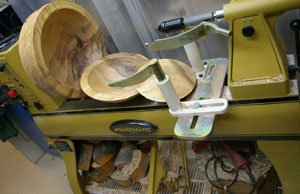
This is my new coring system from Oneway. With this unique tool I can make several bowls from the one origianl, thus saving a great many bags of shavings and giving me many more bowl blanks to work with
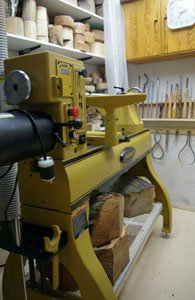
My new lathe arrived in Ottawa on Tuesday and John Lisk and I went up there to pick it up and bring it home. Tom met us here and using a heavy duty dolly we got all of the bits and pieces down into the basement without injury to ourselves or the lathe. We used…
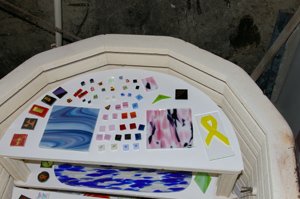
In this photo, you can see the third layer has been added. We are now ready to begin the firing. We heat the kiln slowly for the first 500 degrees and then we can crank it up until we reach 1465 which takes about 3 to 4 more hours. Once the fusing is finished, we leave the klin…

This photo shows how we utilize the kiln to best advantage. The bottom layer is in and we have added the stilts and another set of ceramic shelves to hold this load of glass. So we are almost ready to begin heating the kiln. We just need to add a final set of shelves and…

This picture shows how we load the kiln for a fusing firing. Here we have several layers of glass on top of each other. Glass as it fuses moves to a thickness of 1/4 inch so if we wish to retain a shape it is important we have 1/4 inch of glass in layers. The…
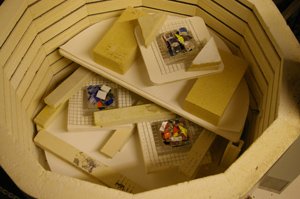
This picture shows the kiln as it is loaded for a wire melt firing. We are trying 3 small ones this time. Each piece of wire is supported by some fire bricks to raise it off the kiln shelf. The higher we raise it the more circular swirls we will get. Ann and I play…
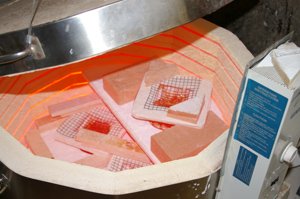
Here is a picture of the kiln as it works its magic. The temperature now is about 1760degrees . You can see the pieces of wire with the glass on top and if you look closely you can see some of the melted glass below the very top one. On this firing, we are doing…
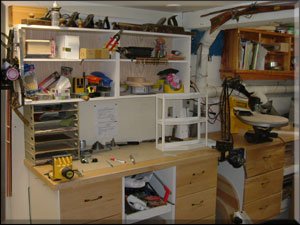
The woodshop in our basement formerly was a playroom, computer room and bedroom. When Christine went to university, a wall came crumbling down. The result of this “accidental deconstruction” was that Ron’s workshop now has MUCH more space available for tools and working on projects.
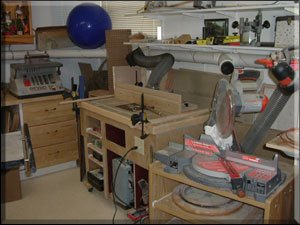
All of the large tools Ron uses – the mitre saw, router table and oscilating sander shown here – are interconnected via a central dust collector. Despite his best efforts, Ron is still accused of tracking dust all over the house by other members of Sawdust & Glass. He even went so far as to…

The central area of the workshop has several work stations – table saw shown above – on castor wheels to allow creation of projects big and small. It sometimes can be a bit of a logic puzzle as to the best place to position tools and any of the two or three projects seemingly always on…
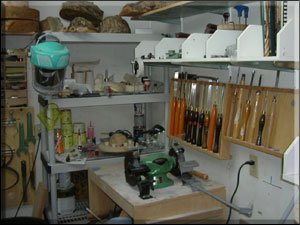
To turn the burls into finished woodturnings, Ron uses a variety of chisels. I’m sure you can imagine with all the burls he’s got stored away in here why the company is named Sawdust & Glass. I’m sure our house would fetch top dollar on the gerbil housing market 🙂 And a woodturner/woodworker can never…
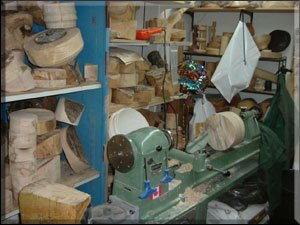
I used a General 160 variable speed electric lathe to create the bowls, lamps and other woodturnings up until April of this year. I purchased a new Powermatic 3520B lathe at that time. I collect burls from all over Ontario and on our travels. If you know of someone that has some unique wood or burls please give us…
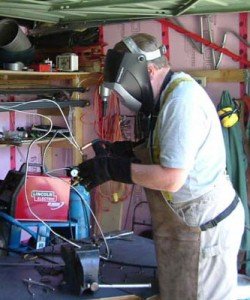
The sparks really fly when Ron gets started. He took an excellent course at St. Lawrence College with Ken Compeau to learn the trade as electricity can be very dangerous. We are beginning to experiment with metal in some of our products. At one point in time there was a very spacious garage in this…
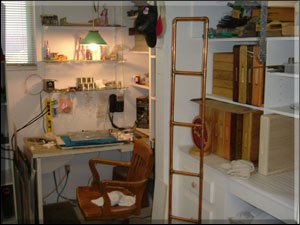
Ron solders all of the stained glass projects in this area which is actually physically located in the main wood workshop. On average we go through anywhere from 3 to 6 one pound coils of solder in a month.

Glass used for fusing must be kept separate from regular stained glass. If glass with different co-efficients of expansion are mixed in the kiln, they will crack. The rate of heating and cooling must be carefully monitored to avoid stress factures and on average a load in the kiln can take up to 18 hours…
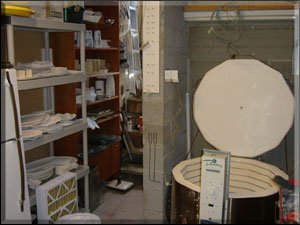
The Duncan Pro-Boss Kiln was purchased at an auction in 2003 and has been running non-stop ever since. We have made or purchased several ceramic and stainless steel moulds to be able to produce a wide variety of beautiful creations. The majority of the ceramic moulds we get from a company called Lillinas Ceramics (613-386-7247)….